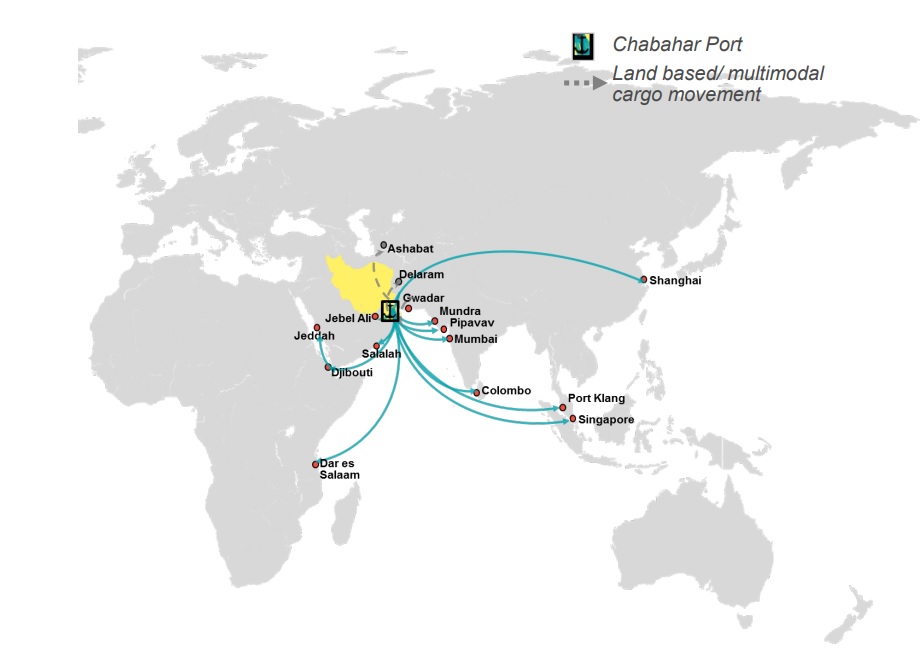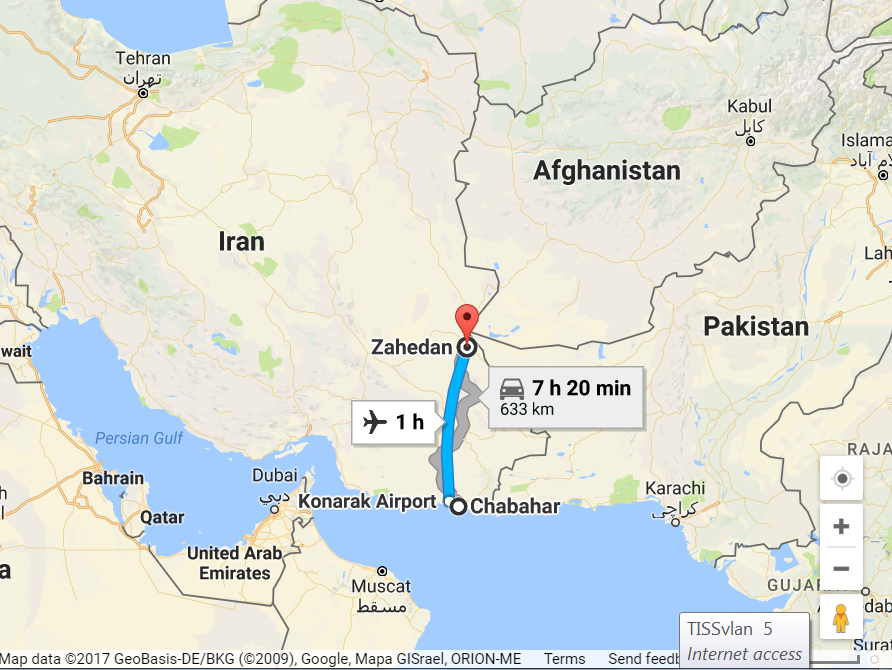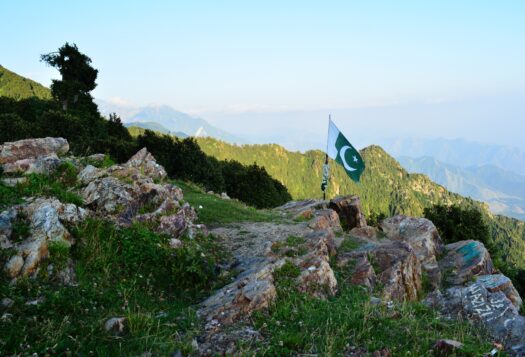
Finally free of Western sanctions that restricted its economy, Iran is looking to exploit its strategic location for economic benefit. Being a viable transit point for access to the Central Asian region and Afghanistan, Iran has joined hands with India and Afghanistan to realize this potential through the development of the Chabahar port. Though the deal to renew Chabahar port was signed in 2003, it got stalled as a result of the Western embargo, constricting external states’ ability to engage with Iran. However, the recent finalization of the Chabahar agreement is an ambitious attempt to revitalize Indo-Iranian engagement post embargo.
Project Scope and Components
The Chabahar Port Agreement needs to be viewed within the larger context of the International North-South Transport Corridor (INSTC), of which India is a founding member. INSTC is a 7,200-km multi-modal (ship, rail, and road) transportation corridor which aims to connect India, Iran, and Russia through the Indian Ocean, Persian Gulf, and the Caspian Sea.
The Chabahar project has three components: ports, a trade corridor in the form of railway lines and roads, and the Chabahar Free Trade Zone.

Source: JNPT, 2016.
Development of Ports
Currently, Iran can only receive 100,000-ton cargo ships through its Bandar Abbas port, and most shipping is conducted by much larger vessels. Indian investment in Chabahar would alleviate this issue by equipping it to receive 250,000-ton cargo vessels – a significant increase in capacity. Countries like Japan and South Korea have also offered to invest in Chabahar, which would diversify Iran’s trading partners.
The agreement allows the berths at Shahid Beheshti Terminal to be operated for a period of ten years by India Ports Global, a joint venture between Jawaharlal Nehru Port Trust and Kandla Port Trust, in collaboration with Iran’s Arya Bander. After a two-year grace period, India must guarantee 30,000 TEUs of cargo at the Chabahar port. By the end of the tenth year, this number should reach 250,000 TEUs. The berths are scheduled to be completed within 18 months at an estimated cost of $85 million. Under phase one of the agreement, India Ports Global will build two 640-meter container berths and three 600-meter multipurpose container terminals. Chabahar’s capacity is expected to jump from 2.5 million tons to about 8.5 million tons.
India will reap significant economic and strategic benefits from the development of Chabahar port. Economically, it provides an alternate route for India to trade with Afghanistan, Central Asia, and Russia. Strategically, it will enable India to play a more constructive role in the Afghan-led peace process.
Trade Corridors
The second key aspect of the Chabahar Agreement is the development of a trade corridor. India has agreed to construct a railway line linking Chabahar to Zahedan. It aims to “facilitate better regional connectivity, including between India and connections to Afghanistan and Central Asia.” It will allow Afghan goods to be transported from Zahedan to Chabahar and then shipped back to India. India’s swift construction of the 215 km Zaranj-Delaram highway, which borders Iran, is also an attempt to augment linkages with Afghanistan.

Source: Google Maps
Afghanistan will largely benefit from these linkages as well. Currently, Afghanistan is highly dependent on Pakistan for trade, and amidst the rising political tension between Kabul and Islamabad, Afghanistan exports via Karachi have declined by 40 percent. An alternative trade route to the Indian Ocean would significantly reduce Afghani dependence on Pakistan for trade, thus enhancing its autonomy.
Chabahar Free Trade Zone
Another vital component of the agreement is the Chabahar Free Trade Zone, with a total area of 14,000 hectares. India plans to invest billions in the zone through industries such as aluminum smelter and urea plants. Nitin Gadkari, the Indian Road Transport, Highways and Shipping Minister, has mentioned that Iran has cheap natural gas and power that Indian firms are keen to tap into. The Chabahar Free Trade Zone would also boost the Iranian economy, which had an unemployment rate of around 12.4 percent in 2016, especially in the conflict-ridden Sistan and Baluchistan province. It will also be instrumental in reintegrating Iran into the global economy.
Geopolitics and Challenges
The recent strain in United States-Iran ties, especially with President Trump’s denouncement of the nuclear agreement as a “bad deal” and the administration’s claim that Tehran was “on notice” after test-firing a ballistic missile, has the potential to impede progress as well. If the relationship deteriorates further and more sanctions are imposed, investment in the region will be severely affected. For example, newly-imposed sanctions on Iran by the U.S. Treasury Department could curb progress of projects such as the development of Iran’s Farzad-B offshore gas field, which was proposed by ONGC Videsh Limited (OVL), or the aluminum smelter project by NALCO.
Pakistan’s unease with the Chabahar Agreement adds to these complexities. Some analysts in Pakistan view the agreement as an Indian ploy to encircle the country, regardless of the potential benefits it could accrue to Afghanistan in particular and the region in general. Islamabad is mainly concerned with an increased Indian presence in the region as well as possibly losing out on engagement with Iran.
Another consideration should be the potentially competing projects that Iran has with other players, especially if India delays Chabahar. Iran is vying for Chinese investment in the region, to which China has reacted positively. This would allow China to expand its Belt and Road Initiative and provide an alternate access route to the Gulf.
The success of the connectivity corridor is also contingent upon the security situation in the region. Safeguarding the project in conflict-ridden zones will remain a challenge. To address this concern, the participating countries should place an emphasis on negotiation and consensus-building with local stakeholders. The employment needs of the local population should be prioritized, such as through recruiting locals in law enforcement to enhance project security. This would foster more local support for international investment.
Looking Ahead
Although the port will be beneficial to all parties involved, progress has been far from satisfactory. In order for the agreement to commence, the Export-Import Bank of India (Exim) must receive a loan disbursal application from the Port and Maritime Organization of Iran. Eight months have passed since the loan agreement was signed, and Exim bank has yet to receive the application, without which the credit cannot be processed. India and Iran need to expedite these bureaucratic processes to realize the benefits of Chabahar port.
Notwithstanding these challenges, both the countries have done well in maintaining momentum regarding the Chabahar Agreement. It is pertinent for Iran, under President Rouhani, to continue on the path of cooperation, not only for its own economic prosperity but also for the region at large.
***
Top Image: Narendra Modi Flickr


